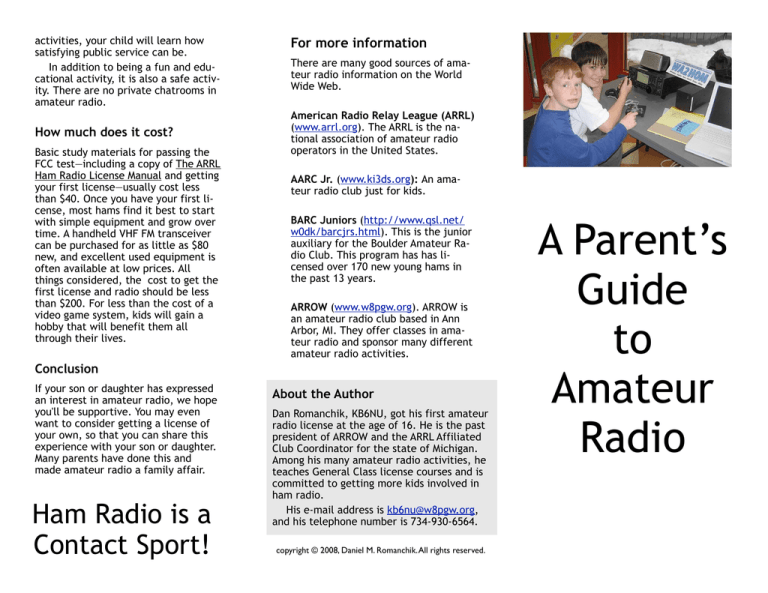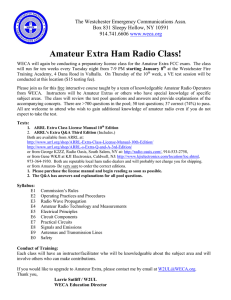
activities, your child will learn how
satisfying public service can be.
In addition to being a fun and educational activity, it is also a safe activity. There are no private chatrooms in
amateur radio.
How much does it cost?
Basic study materials for passing the
FCC test—including a copy of The ARRL
Ham Radio License Manual and getting
your first license—usually cost less
than $40. Once you have your first license, most hams find it best to start
with simple equipment and grow over
time. A handheld VHF FM transceiver
can be purchased for as little as $80
new, and excellent used equipment is
often available at low prices. All
things considered, the cost to get the
first license and radio should be less
than $200. For less than the cost of a
video game system, kids will gain a
hobby that will benefit them all
through their lives.
For more information
There are many good sources of amateur radio information on the World
Wide Web.
American Radio Relay League (ARRL)
(www.arrl.org). The ARRL is the national association of amateur radio
operators in the United States.
AARC Jr. (www.ki3ds.org): An amateur radio club just for kids.
BARC Juniors (http://www.qsl.net/
w0dk/barcjrs.html). This is the junior
auxiliary for the Boulder Amateur Radio Club. This program has has licensed over 170 new young hams in
the past 13 years.
ARROW (www.w8pgw.org). ARROW is
an amateur radio club based in Ann
Arbor, MI. They offer classes in amateur radio and sponsor many different
amateur radio activities.
Conclusion
If your son or daughter has expressed
an interest in amateur radio, we hope
you'll be supportive. You may even
want to consider getting a license of
your own, so that you can share this
experience with your son or daughter.
Many parents have done this and
made amateur radio a family affair.
Ham Radio is a
Contact Sport!
About the Author
Dan Romanchik, KB6NU, got his first amateur
radio license at the age of 16. He is the past
president of ARROW and the ARRL Affiliated
Club Coordinator for the state of Michigan.
Among his many amateur radio activities, he
teaches General Class license courses and is
committed to getting more kids involved in
ham radio.
His e-mail address is kb6nu@w8pgw.org,
and his telephone number is 734-930-6564.
copyright © 2008, Daniel M. Romanchik. All rights reserved.
A Parent’s
Guide
to
Amateur
Radio
What is amateur (ham) radio?
Amateur radio, also known as ham radio, is a hobby enjoyed by hundreds of
thousands of Americans and millions
around the world. They enjoy communicating with one another via two-way
radios and experimenting with antennas and electronic circuits.
All kinds of people are amateur radio operators, also known as "hams."
Hams are young, old, men, women,
boys, and girls. Kids as young as seven
years old have gotten amateur radio
licenses and many hams are active
into their 80s and beyond.
You never know who you'll run into
on the amateur radio bands: young
and old, teachers and students, engineers and scientists, doctors and
nurses, mechanics and technicians,
kings and entertainers. People from
all walks are amateur radio operators.
For example, did you know that
most of the astronauts sent up to the
International Space Station (ISS) in the
last five to ten years have been licensed radio amateurs? They use the
amateur radio station on board the ISS
to communicate with school groups all
over the world.
How do you get into amateur
radio?
With just a little study, your kids (and
you as well!) can learn all they need
to know to get a Technician Class license. There are plenty of resources
available today to help, including The
ARRL Ham Radio License Manual, the
Technician Class license manual published by the American Radio Relay
League.
The Technician Class license is the
most popular license for beginners. To
get a Technician Class license, you
must take a test with 35 multiplechoice questions. The test covers basic regulations, operating practices,
and electronics theory. Knowing Morse
Code is not required to get this license. Technician Class licensees have
all amateur radio privileges above 30
MHz, including the very popular 2meter band.
They can also operate voice and
digital modes on the 10m band and
Morse Code (CW) on the 80m, 40m,
15m, and 10m bands. These privileges
allow them to experience the magic of
shortwave radio.
Many amateur radio operators then
choose to upgrade to the General
Class license. Amateurs with a General
Class license are allowed to operate
on shortwave frequencies, which are
the frequencies normally used for
cross-country and worldwide communication. To get a General Class license, you must pass another 35question multiple-choice examination.
This exam covers intermediate regulations, operating practices, and electronics theory, with a focus on shortwave applications.
What do kids get out of amateur radio?
Being involved in amateur radio is
beneficial for kids in many ways. They
will, for example, learn about electronics and radio propagation; expand
their knowledge of geography and enhance their personal communication
skills. An interest in amateur radio
gives them knowledge that will help
them succeed in school and in life. It
often kindles an interest in math and
science, which can then lead to a career in science or engineering.
In addition to technical skills, kids
will also learn social skills. It's often
said that amateur radio is a "contact
sport." In making contacts with other
amateur radio operators, your child
will make friends with other hams
around the country and around the
world. This, in turn, will help them
learn about other cultures and the
world we live in.
Amateur radio also teaches children the value of public service. Part
of amateur radio's reason for being is
to provide emergency communications
and other public service communications. By taking part in those

